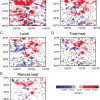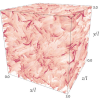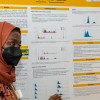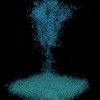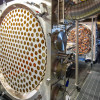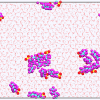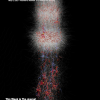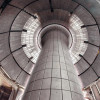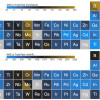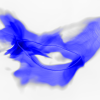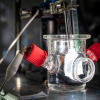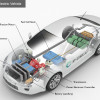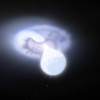Science News
New Climate Models Reveal Geographical Link Between Wildfires and Extreme Weather
A climate study led by PNNL researchers used NERSC resources to investigate a growing connection between wildfires in the Western U.S. and extreme weather in the Central U.S. The team ran a series of models on Cori and detected an evolving relationship between wildfires in one region and frequencies of heavy rainfall and large hail in the other. Read More »
NERSC’s Cori System Helps Shed New Light on Plasma Turbulence
With the help of supercomputers at NERSC, Columbia University, and NASA, astrophysicists ran large-scale simulations that show the precise movements of electrons and ions in the sun’s plasma. Read More »
NERSC Summer Student Puts MPI Under the Microscope
This summer, as part of the Berkeley Lab Computing Sciences Summer Program, Muna Tageldin developed a microbenchmark to analyze variances in message-passing interface (MPI) performance on NERSC systems and look for the best statistical methods to characterize the results. Read More »
HPSS: Celebrating 30 Years of Long-term Storage for Scientific Research
This year marks the 30th anniversary of the HPSS Collaboration, a partnership between five DOE national laboratories and IBM. Today the High Performance Storage System is still going strong, serving some 40 sites around the world and more than 4 exabytes of production archival storage data. Read More »
Materials Science Simulation Achieves Extreme Performance at NERSC
Powered by the new Perlmutter system at NERSC at Berkeley Lab, a team of researchers led by Paderborn University scientists Thomas D. Kühne and Christian Plessl used a new mixed-precision method to conduct the first electronic structure simulation that executed more than quintillion operations per second. Read More »
LUX-ZEPLIN Data-Management Needs Fuel Team Approach
The National Energy Research Scientific Computing Center (NERSC) and the Energy Sciences Network (ESnet) located at Lawrence Berkeley National Laboratory (Berkeley Lab) are playing a critical role in facilitating the burgeoning LUX-ZEPLIN (LZ) experiment in its search for dark matter in the universe.Located deep in the Black Hills of South Dakota in the Sanford Underground Research Facility (SURF), the uniquely sensitive LZ dark matter detector recently passed a check-out phase of startup… Read More »
NERSC Summer Student Works Toward Machine Learning for a Rainy Day
As part of the 2022 Berkeley Lab Summer Student program, UC Berkeley PhD student James Duncan works to improve the resolution of precipitation models using machine learning, aiming to produce more accurate weather prediction. Read More »
NERSC Simulations Target ‘Forever Chemicals’ in Soils
With the growing awareness about the risks posed by “forever chemicals” in our water, soil, plants, and more, researchers are making new inroads into understanding how these substances function and how we might be able to mitigate their harmful effects. Fortunately, supercomputer simulations are aiding in these efforts. Read More »
Neuroscience Simulations at NERSC Shed Light on Origins of Human Brain Recordings
Using simulations run at NERSC, a team of researchers at Berkeley Lab has found the origin of cortical surface electrical signals in the brain and discovered why the signals originate where they do. Read More »
Simulations at NERSC Drive Progress Toward Nuclear Fusion
Simulations performed at NERSC at Berkeley Lab have brought researchers one step closer to producing efficient, endlessly renewable energy through nuclear fusion, harnessing the process that produces light and heat in our Sun and other stars. Read More »
Machine Learning Fuels Materials Science and Search in Continuous Action Spaces
Using computing resources at NERSC at Berkeley Lab, researchers at Argonne National Laboratory have succeeded in exploring important materials-science questions and demonstrated progress using machine learning to solve difficult search problems. Read More »
Researchers Narrow Down Mass of Sought-After Axion Particle
Researchers at Berkeley Lab and other institutions have narrowed the range of possible masses for the axion, a theoretical particle that may make up much of the dark matter in the universe. Read More »
San Francisco and Berkeley Lab Team Up on Pioneering Climate Study
Berkeley Lab computational resources are helping the City and County of San Francisco adapt to the Bay Area's changing climate and the extreme storms it is expected to bring. Read More »
Berkeley Lab Helps Fuel Advances for Renewable Energy Sources
Simulations run at NERSC could enhance the development of a new artificial photosynthesis device component – a promising step forward in validating the viability of renewable fuels. Read More »
Hydrogen Fuel Cells: An Environmentally Friendly Transportation Alternative
In the quest to develop alternatives to fossil fuels for a variety of transportation methods, environmentally friendly hydrogen fuel cells are finding favor – and funding. Read More »
Berkeley Lab Computing Resources Enable Deeper Understanding of Supernovae Explosions
An international research team recently made history by recording the earliest post-explosion detection of a Type Ia supernova, using cosmological models developed at Berkeley Lab and supercomputing resources at NERSC. Read More »
X-Ray Crystallography Goes Even Tinier
Supported by high-performance computing resources at NERSC, scientists at Berkeley Lab have debuted a new form of X-ray crystallography for small molecules not previously conducive to investigation with crystallography. Read More »






